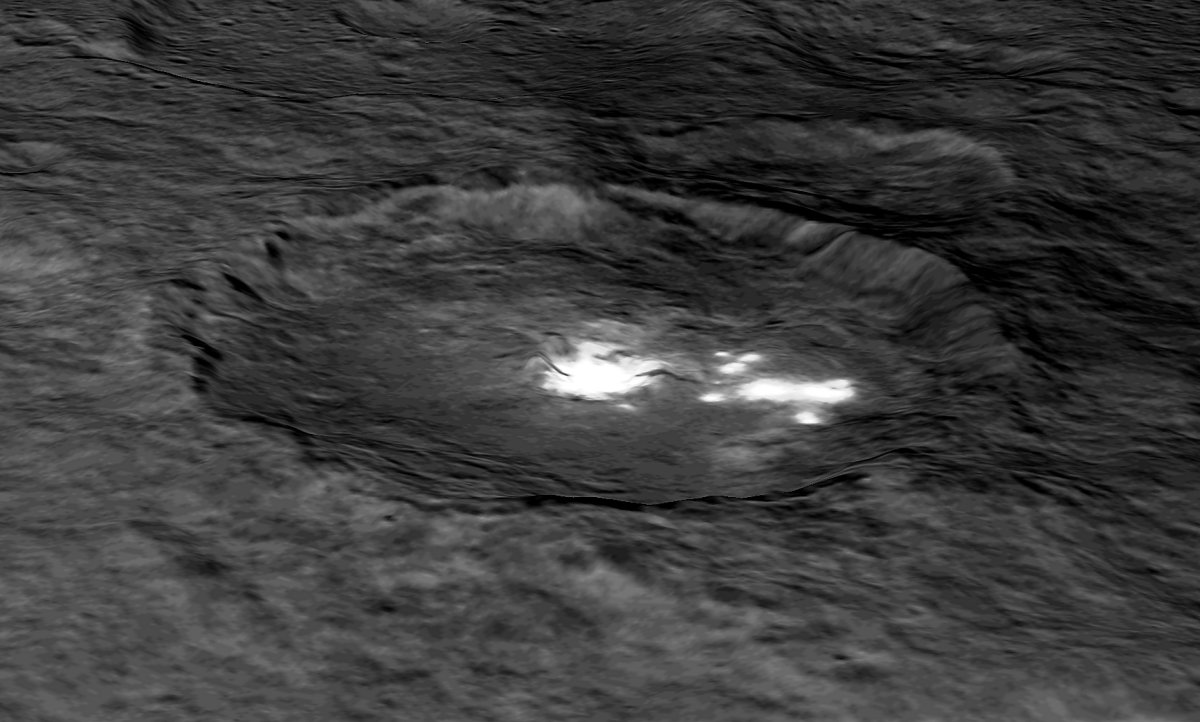Ceres And Occator Crater Reveal Some Of Their Best-Kept Secrets
MessageToEagle.com – Ceres – a dwarf planet and the largest object in the asteroid belt, which lies between the orbits of Mars and Jupiter – reveals some of its well-kept secrets.
Thanks to data delivered by NASA’s Dawn spacecraft, two new studies include highly anticipated insights about mysterious bright features found all over the dwarf planet’s surface.
In one study, led by Andreas Nathues at Max Planck Institute for Solar System Research, Göttingen, Germany, scientists identify this bright material as a kind of salt. Ceres has more than 130 bright areas, and most of them are associated with impact craters.

This study claims that the bright material is consistent with a type of magnesium sulfate called hexahydrite. A different type of magnesium sulfate is familiar on Earth as Epsom salt.
“The global nature of Ceres’ bright spots suggests that this world has a subsurface layer that contains briny water-ice,” said Nathues, who along with his colleagues suggest that these salt-rich areas were left behind when water-ice sublimated in the past. Impacts from asteroids would have unearthed the mixture of ice and salt.
The surface of Ceres, whose average diameter is 584 miles (940 kilometers), is generally dark — similar in brightness to fresh asphalt — study authors wrote. The bright patches that pepper the surface represent a large range of brightness, with the brightest areas reflecting about 50 percent of sunlight shining on the area. But there has not been unambiguous detection of water ice on Ceres; higher-resolution data are needed to settle this question.
Dark streaks, possibly fractures, traverse the pit. Remnants of a central peak, which was up to 0.3 miles (0.5 kilometers) high, can also be seen.
Study authors write that some views of Occator appear to show a diffuse haze near the surface that fills the floor of the crater. This may be associated with observations of water vapor at Ceres by the Herschel space observatory that were reported in 2014. The haze seems to be present in views during noon, local time, and absent at dawn and dusk, study authors write.
This suggests that the phenomenon resembles the activity at the surface of a comet, with water vapor lifting tiny particles of dust and residual ice. Future data and analysis may test this hypothesis and reveal clues about the process causing this activity.

“The Dawn science team is still discussing these results and analyzing data to better understand what is happening at Occator,” said Chris Russell, principal investigator of the Dawn mission, based at the University of California, Los Angeles.
In the second study, members of the Dawn science team examined the composition of Ceres and found evidence for ammonia-rich clays, raising questions about how Ceres formed.
They used data from the visible and infrared mapping spectrometer, a device that looks at how various wavelengths of light are reflected by the surface, allowing minerals to be identified.
Ammonia ice by itself would evaporate on Ceres today, because the dwarf planet is too warm. However, ammonia molecules could be stable if present in combination with (i.e. chemically bonded to) other minerals.
The presence of ammoniated compounds raises the possibility that Ceres did not originate in the main asteroid belt between Mars and Jupiter, where it currently resides, but instead might have formed in the outer solar system. Another idea is that Ceres formed close to its present position, incorporating materials that drifted in from the outer solar system – near the orbit of Neptune, where nitrogen ices are thermally stable.

“The presence of ammonia-bearing species suggests that Ceres is composed of material accreted in an environment where ammonia and nitrogen were abundant. Consequently, we think that this material originated in the outer cold solar system,” said Maria Cristina De Sanctis, lead author of the study, based at the National Institute of Astrophysics, Rome.
In comparing the spectrum of reflected light from Ceres to meteorites, scientists found some similarities. Specifically, they focused on the spectra, or chemical fingerprints, of carbonaceous chondrites, a type of carbon-rich meteorite thought to be relevant analogues for the dwarf planet.

But these are not good matches for all wavelengths that the instrument sampled, the team found. In particular, there were distinctive absorption bands, matching mixtures containing ammoniated minerals, associated with wavelengths that can’t be observed from Earth-based telescopes.
Another difference observed by the scientists is that these carbonaceous chondrites have bulk water contents of 15 to 20 percent, while Ceres’ content is as much as 30 percent.
“Ceres may have retained more volatiles than these meteorites, or it could have accreted the water from volatile-rich material,” De Sanctis said.
The study also shows that daytime surface temperatures on Ceres span from minus 136 degrees to minus 28 degrees Fahrenheit (180 to 240 Kelvin). The maximum temperatures were measured in the equatorial region. The temperatures at and near the equator are generally too high to support ice at the surface for a long time, study authors say, but data from Dawn’s next orbit will reveal more details.
More information about Dawn is available at the following sites:
Dawn’s mission is managed by the Jet Propulsion Laboratory for NASA. Dawn is a project of the directorate’s Discovery Program, managed by NASA’s Marshall Space Flight Center in Huntsville, Alabama. UCLA is responsible for overall Dawn mission science. Orbital ATK Inc., in Dulles, Virginia, designed and built the spacecraft. The German Aerospace Center, Max Planck Institute for Solar System Research, Italian Space Agency and Italian National Astrophysical Institute are international partners on the mission team.
MessageToEagle.com
source: NASA










